|
The few Red Osier Dogwoods that we have on Leaning Oaks are along the vernal wetland, in the shadiest, moist part of the ravine. The dense shade makes them difficult to photograph in the entanglement!
Cornus stolonifera has bright, beautiful red (rarely yellow)stems that make it a great shrub to have in a garden for winter colour. The white flowers are in small flat-topped bunches, followed by blue-tinged white berries (drupes) that hang in clusters. Red Osier Dogwood is so named because the twigs are used to make baskets. The bright red stem colour is best on younger shoots and gardens often prune heavily to control the height, increase the branching and maintain shoot colour. A number of named forms of this shrub are available including a dwarf selection. Hardwood cuttings are easily rooted in the late fall after leaves have dropped.
0 Comments
Himalayan Cotoneaster, also known as Khasia Berry, is an naturalised introduced shrub here at Leaning Oaks. For the most part, it goes largely unnoticed on a thin soiled, dry slope in part shade. This year however, the cold snap has come at exactly the right time to catch the foliage at the point of turning and the leaves have turned scarlet, making it stand out like a beacon in the woods. ( Cotoneaster simonsii) is native to the Himalayan mountains of India, Bhutan and Nepal and high elevations of Myanmar. It is sometimes used as hedging material and grown for its dense growth and scarlet berries. I have never seen it become an aggressive weed here, but it is considered such in some other places, particularly in Australia.
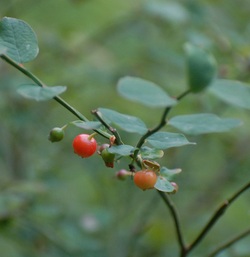 This attractive shrub is scattered throughout Leaning Oaks. Almost every one of them is perched on a decaying stump or log, which seems to be the best habitat for this species, particularly on the drier side of Vancouver Island. The graceful fern-like growth gives the impression of an evergreen because the stems are green and twiggy, but the species is, in fact, deciduous. Unlike most Vacciniums, the berries ripen a bright red instead of the usual blue, purple or black. They are sought after by birds and mammals, including humans. Red Huckleberry is slow picking because of their small size but they make excellent pies and jellies. At Leaning Oaks the recent series of dry summers has hit many of our Vaccinium parvifolium quite hard. The largest individuals have died back, or in some cases, they have succumbed. There has been some recruitment as well, including a handsome specimen on a log that forms one of the edges to our pond. 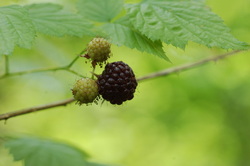 Black Raspberry, or Blackcap is a native shrub that grows long arching stems with a raspberry-like dark purple berry for fruit. The lone plant here at Leaning Oaks grows on the soil disturbed by an the up -rooted tree. The species is usually associated with disturbance. The fruiting stems are two years old when they bear fruit and then they usually die. The berry is very tasty, but sadly, we don't have enough Rubus leucodermis to get a good feed. Other common English names include White-stemmed Raspberry, Western Raspberry or Blue Raspberry. 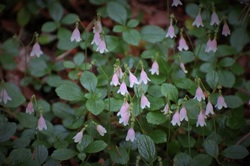 Twinflower is a creeping groundcover most often found in shade. Technically a shrub, Twinflower is in the honeysuckle family. The pale pink flowers are found in pairs and look like tiny lampshades growing on the forest floor. An evening walk in the woods where Linnea borealis grows is a treat, since thats when the plant produces its perfume most strongly. The mat of shiny evergreen foliage is a great foil to the pale pink flowers. It is difficult to tell where the plant stops and starts on the mossy forest floor, there are records of stems growing for more than 10 meters! Twinflower cuttings root easily, and this is a great groundcover for the garden in moist shade. 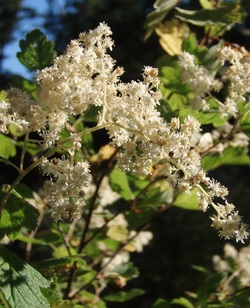 The billowy clouds of cream coloured oceanspray or Holodiscus discolor fill the air with a faint honey perfume and provide multitudes of bees and other insects food and nectar. The blooms that evoke the descriptor of oceanspray start about mid-June until the first week in July. The shrubs grow well...almost too well in open places, particularly with a bit of moisture. This shrub is also known as ironwood -the older wood is truly hard as nails and was used as such. Heating it over a fire made it even tougher. Local aboriginal groups including the Saanich and Cowichan used the wood for spears, building material, halibut hooks and knitting needles. 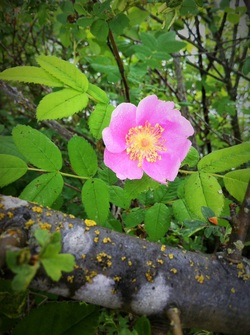 Nootka Rose (Rosa nutkana var. nutkana ) is in full bloom right now and the smell of the flowers is easily detectable when passing a shrub, especially in the evening. Unlike most other roses, Nootka Rose is detectable by one's nose even when its not in bloom, since the foliage has a spicy metallic smell. The smell always reminds me of childhood bike rides, often at the very end of the day - pushing way past the "be home before dark" curfew. The swampy section of Arbutus Road on the north end of Salt Spring Island was detectable by the aromatic foliage of the Nootka Rose -and it signified that the next driveway to the right was home. The flowers of this rose are significantly larger than the flowers of 111. Baldhip Rose, and it grows in much damper locations. Here at Leaning Oaks it is restricted to the very lowest point on the property. In winter, especially in full sun locations, the fruiting bodies or hips are very showy. Rose hip pie is a delicious, but the need to make sure the outer hip is used but all of the irritating hairy seeds are avoided make it a somewhat labour intensive dessert. Baldhip Rose is the commonest wild rose on the property at Leaning Oaks. It is unusual for a rose in that is a shade tolerant species. Most roses retain the sepal crown on the bottom of the fruit (in the same way that an apple does), but this species drops this appendage and the small pear shaped fruit is smooth. The latin name, Rosa gymnocarpa refers to this; gymnocarpa means "naked fruit". The leaves can be used to make a rose tea.
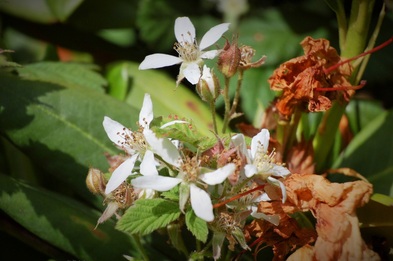 Trailing Blackberry is both beloved and cursed, depending on where an individual plant grows and the nature of your interaction with it. The fruit is wonderful, and this species has been used in breeding programs to produced very flavourful blackberries. In addition, it is one of the parents of the hybrid loganberry, marionberry and boysenberry. The foliage is also very flavourful and is a very good leaf to steep to make blackberry tea. On the other hand, it can be a rapidly growing weed in the garden, fully capable of creeping along the ground or scrambling over shrubs and perennials for several meters in a single growing season. Branch tips often root, and a neglected vine quickly can turn into a big job. The stems are thorny, so pulling without gloves usually gets you a hand full of thorns. Summer strolls in flip-flops or sandals is an excellent way to find this plant, and it becomes painfully obvious why one alternative name is "ankle saw". Rubus ursinus ssp. macropetalus is dioecious, that is males and females are on separate plants. Pity that most of the plants here at Leaning Oaks are male, and therefore don't produce fruit. Alternate common names are Pacific Blackberry, Dewberry, Douglas Berry and California Blackberry. I have several other names for it, best not repeated here. 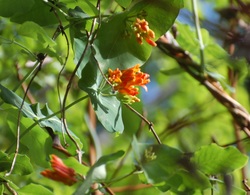 Orange Honeysuckle (Lonicera ciliosa) is one of two species of Lonicera that we have at Leaning Oaks. It is the earlier blooming of the two. Unlike moth pollinated honeysuckles, our native honeysuckle vines are pollinated by hummingbirds, and their showy flowers and large nectaries (but no perfume) are typical of hummingbird pollinated flowers. It is one of the few native vines in our area, and can climb up into the canopy of small trees. Here they grow up Garry Oaks and small Douglas-fir trees. There is no doubt that this is the showiest native shrub that we have at Leaning Oaks. It is a valuable shrub for it's early bloom and ability to attract both species of Hummingbirds. Indeed the arrival of Rufous Hummingbirds seem to be timed to take advantage of Red-flowering Currant and Salmonberry blossoms. In British Columbia, the commonest flower colour is red (pink is commoner further south) but even here we have found plants in the wild that run from white, blush, various shades of pink to brick red and intense scarlet. Not surprisingly, this is a widely available native plant in nurseries. My garden blog on this species is the viewed blog I have written, which shows the interest in this plant. Click here for that blog, which contains a list of some of the cultivars that are available for this species:
http://gardennotesfromleaningoaks.blogspot.ca/search?updated-min=2010-01-01T00:00:00-08:00&updated-max=2011-01-01T00:00:00-08:00&max-results=7 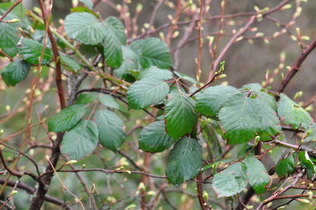 This weed was introduced from India via England into North America in 1855 and was first found in BC in the early 1970's. It is hard to believe that it hasn't been that long given the dense, ecology altering thickets that it can form. The tough poky vines make it difficult to control. It spreads by root and stem fragments as well as birds and omnivorous mammals. Most of the issues that we have with this species (Rubus armeniacus) is around the garden. The berries are yummy but not worth it for the stranglehold that it puts on the native vegetation, garden plants and our ankles. 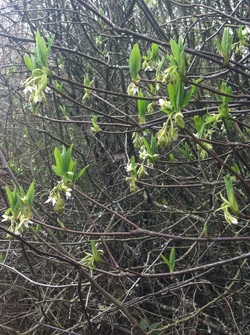 This member of the rose family is the earliest blooming native shrub we have on the property. In most years it starts to bloom in February, although this year the first flowers are starting to open now. Indian Plum usually has separate male and female plants, and although we only have a few on the property, we have some of each. The female plants bear orange drupes (plum-like fruits) that eventually turn deep blue - although they seldom last that way for very long as they are usually eaten by American Robins very quickly. Indian Plum is useful in the garden because of it's early bloom. Plants are easily propagated from hard wood cuttings taken in the fall. 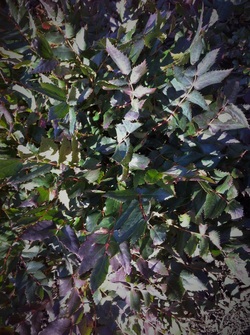 Of the two species of Oregon Grape on the property, this one (Mahonia nervosa) is the more shade tolerant and a nice patch of it grows under the densest patch of older Garry Oaks. The name refers to the matte finish of the leaves when compared to Tall Oregon Grape. Like that species, winter leaf colour varies and some individuals can have winter leaves of purples, reds and even brilliant scarlets. David Douglas; the botanist the Douglas-fir is named after, brought both species back to England for the gardens. Of the two, he preferred this one. I tend to agree, this species is very attractive, seldom requires cutting back, and, by merits of its shade tolerance, often is the answer to a difficult gardening problem - what to plant in dry shade? Berries of both species are edible and make great jelly, either alone or combined with salal berries. 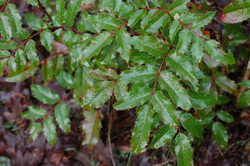 We have two native species of Oregon Grape growing on the property, this one, Mahonia aquifolium and the Dull Oregon Grape (M. nervosa). We grow a third species in the garden. Tall Oregon Grape has shiny leaves that look as if they are wet- hence the latin name, with smaller numbers of leaflets on each leaf. The leaves vary quite a bit from plant to plant in leaflet shape and in winter colour. Some plants have leaves that turn a nice burnished burgandy colour, while most stay green. Yellow flowers in early spring and blue berries in late summer make this a particularly attractive species. This is one of our natives that is used extensively in horticulture. I remember seeing large boulevard plantings of this when we visited Holland a few years ago.  Luckily we have very little Daphne on the property...but every once in a while a few plants pop up. These are quickly pulled! Not only can this plant by invasive and can out compete the native vegetation in undisturbed areas, but it is also toxic. According to the Invasive Species Council of BC (see link below), "the toxins are in the bark, sap and the berries, and if contacted, the sap is known to cause skin rashes, nausea, swelling of the tongue and coma". Nice. Perhaps I will wear gloves the next time that I pull any up! http://www.bcinvasives.ca/general/weed-of-the-week-daphnespurge-laurel  We have two species of Snowberry here at Leaning Oaks. The taller of the two is this one, Common Snowberry (Symphoricarpos albus), which ironically, is the less common of the two. Here they don't always fruit, but when they do the white berries are a welcome sight on dreary winter days. In the spring they have small bell-shaped flowers which are often visited by bumble bees and both Rufous and Anna's Hummingbirds. Snowberries are the food plant for a number of native moth caterpillars including the dapper and unusual Snowberry Bee Hawk Moth (Hemerus diffinis) a daytime flying, bee mimic we most often see feeding on our Dwarf Liliac. 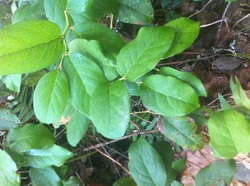 Salal (Gaultheria shallon) is found at Leaning Oaks in scattered patches and we retained many of them when we were developing the garden here. With their evergreen leathery leaves, and edible berry, they are valuable landscape plants, growing in both sun and shade and requiring no supplemental watering. The berry makes an excellent jam/jelly with a foxy flavour that pairs well with game meats and as jam on toast. Salal was an important plant in our family when we were growing up. Our parents, as well as us boys, made extra pocket money picking salal on Salt Spring Island for commercial buyers based out of the Cowichan Valley. I still can't walk past a stand of salal without looking for those prized stems that had a flat spray of evenly spaced, blemish-free leaves. The smell of bundles of salal that were brought into the basement so they could be sorted and carefully picked over so that blemished or torn leaves could be taken off the stems is one of those smells of my childhood. |
AuthorsTwo biologists on a beautiful property armed with cameras, smart phones and a marginal knowledge of websites took up the challenge of documenting one species a day on that property. Join along! Posts and photographs by Leah Ramsay and David Fraser (unless otherwise stated); started January 1, 2014. Categories
All
Archives
May 2025
|
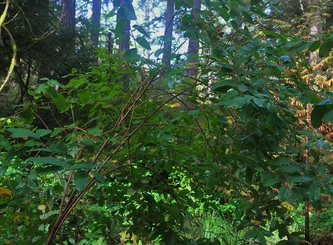
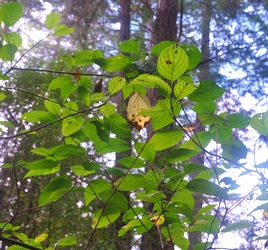
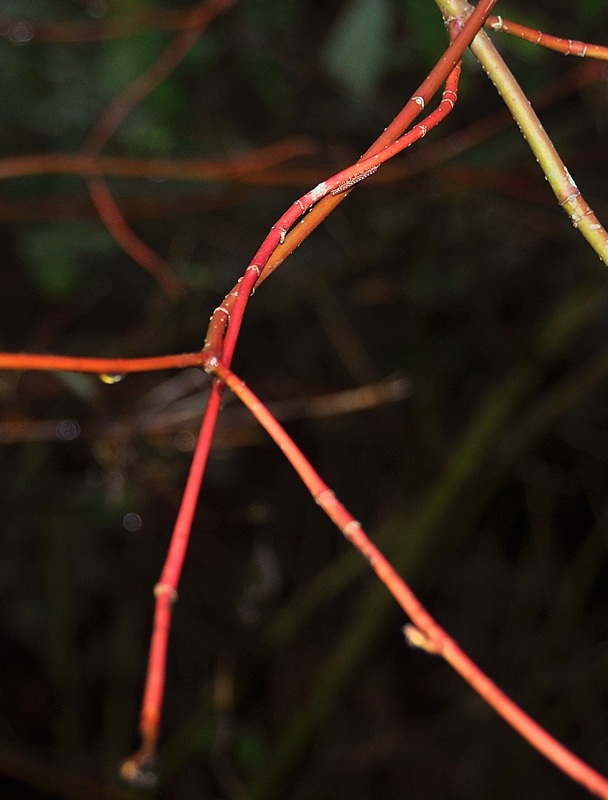
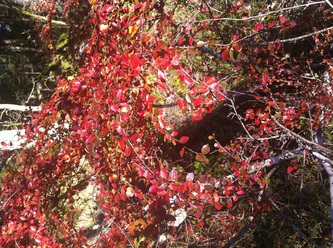
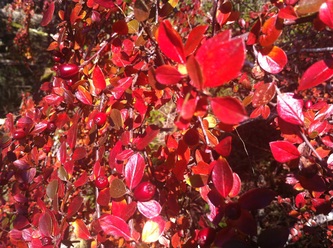
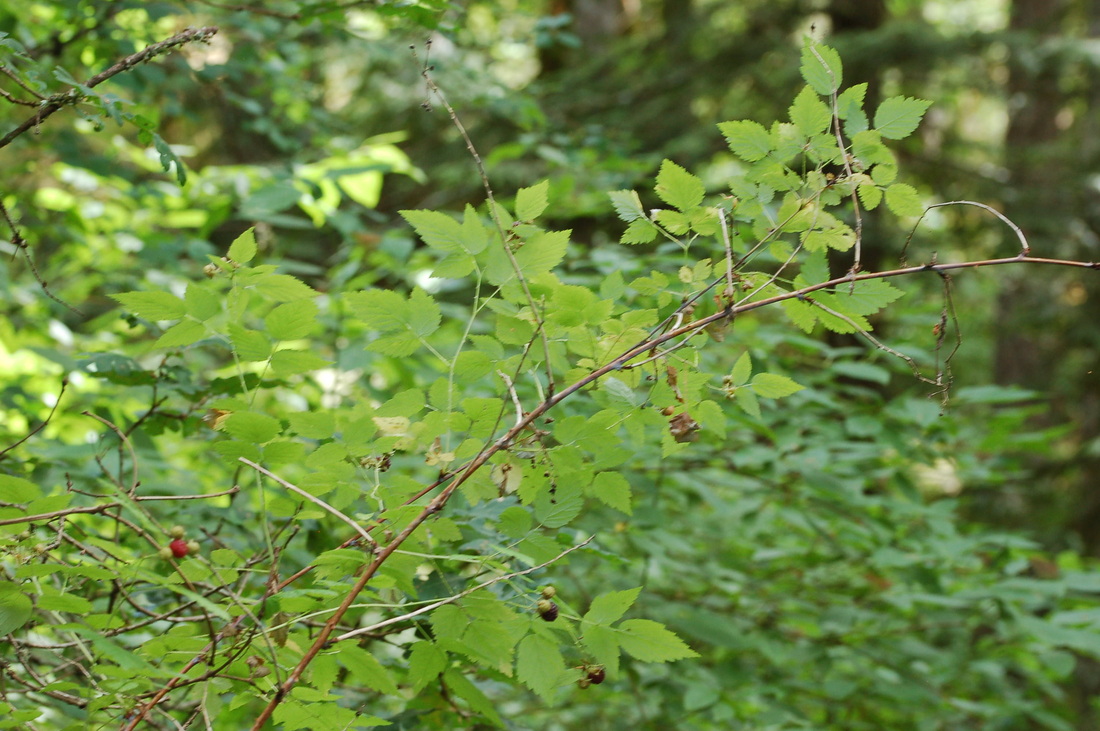
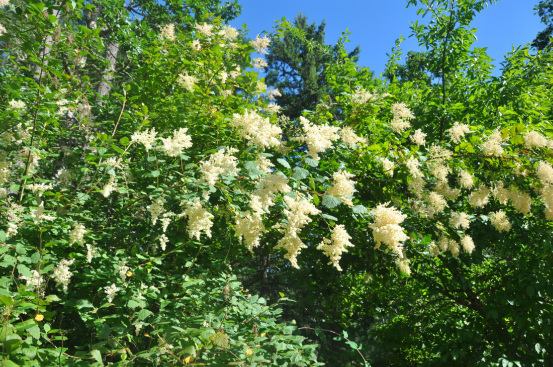
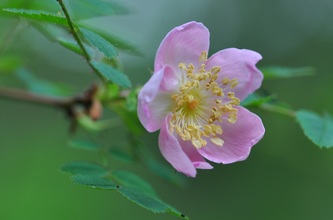
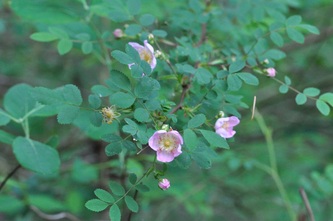
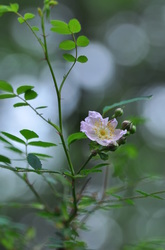

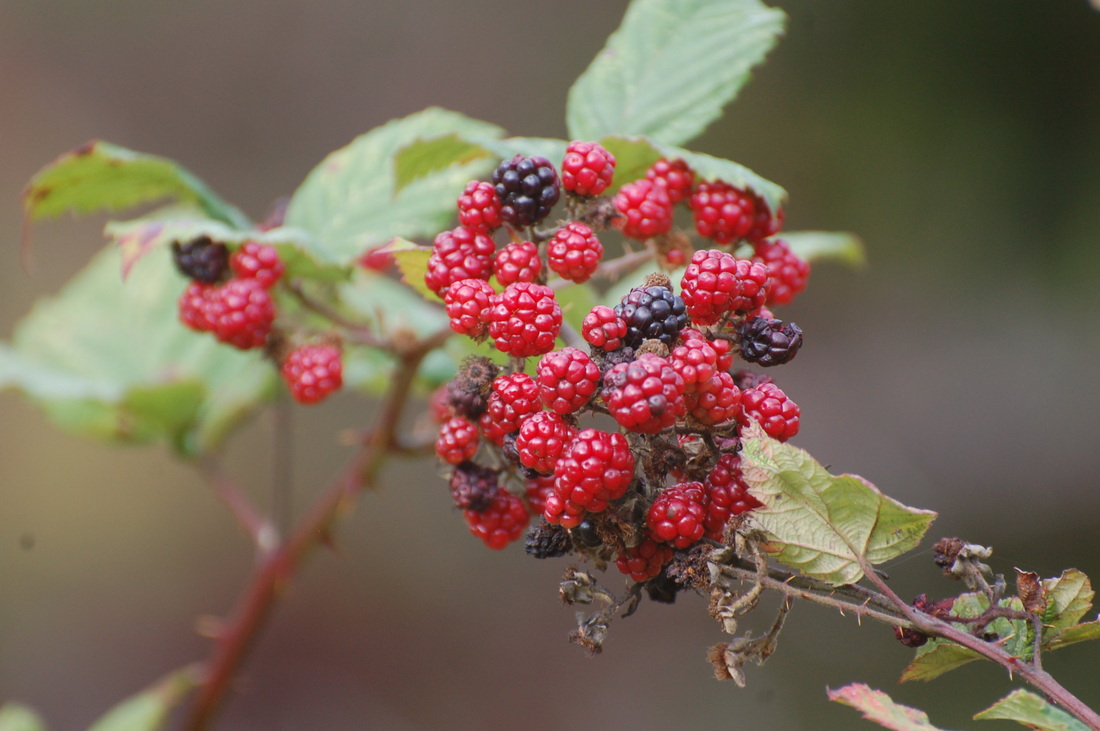

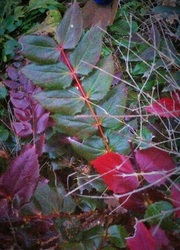
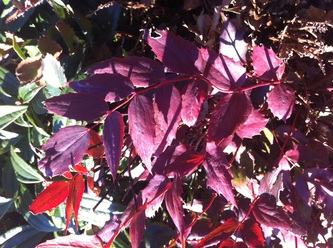

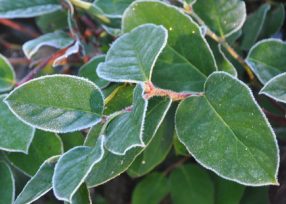
 RSS Feed
RSS Feed